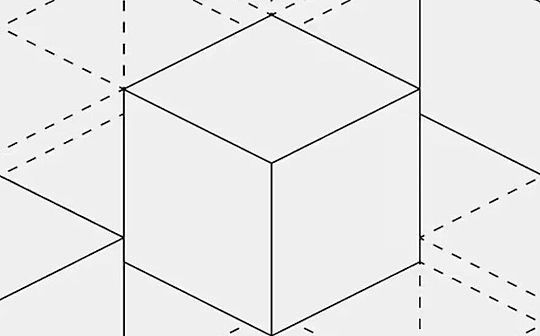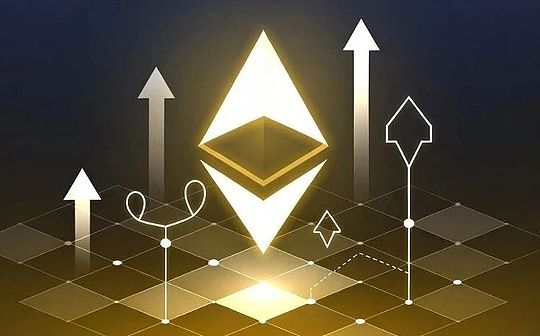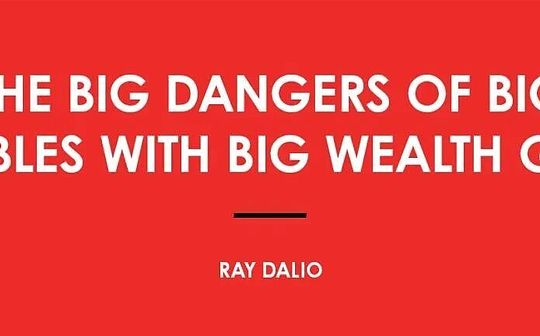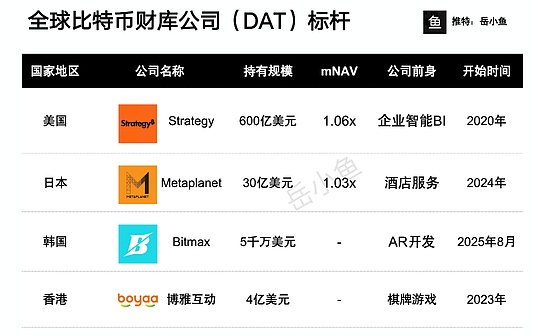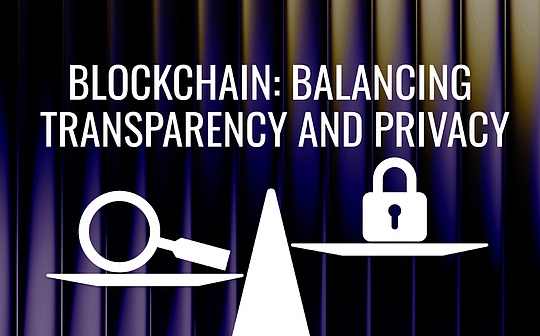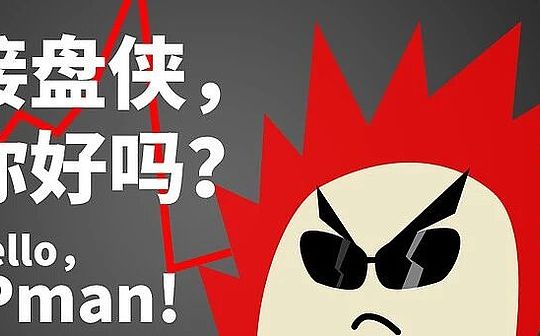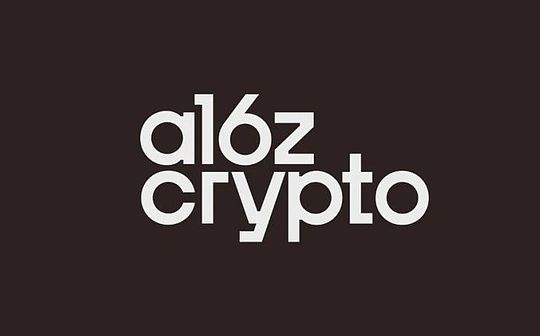
Original title: The DUNA: An Oasis For DAOs
Author: Miles Jennings, David Kerr
Everyone active in web3 has heard of the word “DAO”, the abbreviation for Decentralized Autonomous Organization.DAO is a key tool to keep the blockchain network open and has been working hard to be a benchmark for web3, but there is one topic that cannot be avoided here, that is law and regulation.
This week, Wyoming passed a new bill that incorporates DAOs into legal entities.This will enable the blockchain network to operate within the scope of applicable laws without affecting its decentralized properties.This is a major breakthrough as it will provide much-needed protection to DAOs and empower them with the ability to keep the blockchain network open.
Wyoming has a long history in supporting innovative legal entity structures.The state is the first to adopt a limited liability company (LLC), the first to adopt a non-individual non-profit organization (UNA), and the first to introduce a subset of its LLC regulations for use by DAOs.The new Wyoming law incorporates many of the provisions proposed in the model legislation we have published.
This new entity structure is likely to become the industry standard for blockchain networks created in the United States.So, here is all you need to know about the Decentralized Non-Political Non-Profit Organization (DUNA) in Wyoming.
1. What is DUNA?
On March 7, 2024, SF50, the “Wyoming Decentralized Non-Political Association Act”, was signed and officially became law with an effective date of July 1, 2024.The bill is closely related to Wyoming’s existing Non-Profit Association Act, but it is specially designed for decentralized organizations.
Just as Wyoming’s previous DAO laws (W.S. 17-31 Supplementary of Decentralized Autonomous Organizations) can be considered as “Digital LLC (Digital LLC),” SF 50 can be considered as “Digital UNA).
Additionally, one can think of it as the Web3 version of Town Council.The purpose of town councils is to protect the standards and operations of the town by enforcing the rules and agreements of the community, thus ultimately serving the interests of their citizens, as well as their homes and businesses.
Similarly, DUNA’s purpose is to protect and support the underlying blockchain network, but like town councils, it is not a company in itself.
2. Why is DUNA necessary?
Entrepreneurs around the world are using blockchain technology to build a better Internet, which is the basis for bringing the Internet back to its open network.But if we let companies have these networks, we will eventually fall into the current situation we are facing again, namely, our entire digital world is controlled by a handful of giant companies.
Blockchain technology provides a reliable solution to this problem.It makes it possible to create open blockchain networks that are more like public infrastructure than proprietary technology, meaning that anyone can build on these networks, just like anyone currentlyAll can use open Internet networks (such as emails and websites, etc.) to build a business the same way.
DAO is composed of community members who manage open blockchain network transactions.They are key tools to ensure that the network remains open, treated indiscriminately and does not unfairly extract value.DUNA helps them achieve this by addressing three key challenges facing DAOs.It gives DAOs a legal status that enables them to enter into contracts with third parties and have legal entity attributes, while it enables DAOs to become taxpayers and provides them with limited liability for the actions of other members.All of this is commensurate with other legal entities and is protected by the U.S. judicial system.
DUNA addresses these challenges without increasing the additional risks to consumers.DUNA can be used for decentralized governance of open blockchain networks, but anyone who builds consumer-facing applications on top of these open networks, such as social media apps, automotive services or music streaming apps, will continue to use traditionform of legal entity, such as a company or limited liability company.Although this paradigm includes the use of companies, the fundamental difference is that companies no longer control the underlying network, they only control user-oriented applications.This difference greatly reduces their ability to extract value like web2 companies.
The future of web3: proprietary clients operated using a normal Internet entity architecture, but built on a public infrastructure composed of smart contract protocols run by DAOs and blockchain networks.
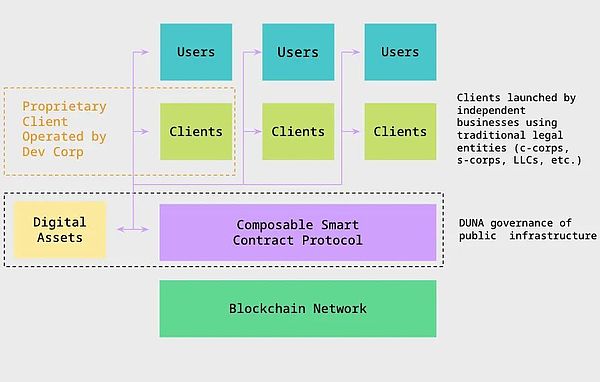
3. Why should DAO use DUNA?
Membership and participation of DAOs currently face some legal risks.DAOs that fail to use legal entities for their organizations cannot have legal rights, such as being unable to pay taxes, and face potential liability risks.At the same time, the lack of legal entities also threatens the privacy of DAO members.Due to these risks, the failure to use legal entities hinders the decentralization of blockchain networks, limits its growth, and hinders the development of economic models of such systems.
If the DAO fails to adopt legal entities, these risks can lead to worse outcomes until a better solution emerges.For example, regulatory actions and class action lawsuits in the United States claim that a DAO without a legal entity is just a general partnership (General Partnership).While there are several strong arguments to challenge these allegations, this classification will be disastrous for DAO members, which will put them in unbearable tax risks and legal liability.Judging from the current situation, the advantage lies with the regulator and the plaintiff.If their theories are spread and succeed, this may even be the death knell of decentralized governance.
DUNA prevents the possibility of this situation worsening, addresses key challenges facing DAOs and greatly reduces the risks facing DAO members.It provides DAOs with legal status, enabling them to contract with third parties, open bank accounts, and provide simple tools for the service process.It enables DAOs to pay taxes and meet their information reporting requirements.It protects the privacy of DAO members from the federal government.And, it provides liability protection to DAO members.
It achieves all these requirements without interfering with the way DAO is currently launched and operated, protecting the fundamental principle of decentralization and enabling DAO to effectively develop the ecosystem of its underlying blockchain network.
4. If DUNA is a nonprofit organization, can they engage in for-profit activities?
The answer is yes.Both UNA and DUNA can engage in for-profit activities under Wyoming law.This will include operating decentralized transaction protocols, decentralized social media protocols, and everything you can think of.
Wyoming’s DUNA regulations also explicitly allow reasonable remuneration for any services provided to the DUNA ecosystem.This feature promises to enable DUNA to compensate members who help promote their growth without extracting value from users.This is crucial because it ensures that the blockchain network can operate in a decentralized manner and compete with the centralized enterprise network.
For example, using this feature, DAOs can pay their members in exchange for governance participation.In this case, the reason DUNA rewards people for voting or delegating may be that, by regulations, DUNA does not have centralized management and therefore needs to rely on its members to manage all of its transactions.Therefore, to ensure proper management of DUNA, a large amount of participation is necessary, and DUNA can provide compensation for members to achieve this.
While Wyoming courts will ultimately decide what compensation is justified, there are a large number of real examples of nonprofits that can be inferred.Furthermore, the uniqueness of blockchain networks also provides a solid foundation for debate on the justification of member compensation.For example, since blockchain networks are usually open source, anyone can “fork” (copy), the continued adoption and development of a specific blockchain network that collects fees and distributes compensation to members also actually represents the continued adoption and development of a specific blockchain network that collects fees and distributes compensation to members.Users have a destined approval of the rationality of the network’s payment compensation, otherwise they will start an alternative network (for example through fork).
Nevertheless, the qualifier of “reasonable” does put an upper limit on the value that blockchain networks can extract from users and use for member compensation.While those who wish to design vertical integration and centralized blockchain products and services may be confused by the barriers to value extraction, this concept is consistent with, rather than opposing, the spirit of blockchain networks.If the web3 blockchain network ends up taking value from users in the same way as the web2 enterprise network (e.g., Apple charges 30% of the AppStore product), then Web3 will fail.Wyoming’s approach supports the web3 spirit while still providing cash flow to digital asset holders.This is a major breakthrough.
5. What impact will the use of DUNA have on securities laws?
According to the Howey test, which is a test that determines whether U.S. securities laws should apply to digital asset trading, three elements must be met.There must be (1) money investment, (2) in a common enterprise, and (3) reasonable expectations of profits are based mainly on the management efforts of others.
Supporters of blockchain technology have long believed that none of these are met for the vast majority of digital asset transactions.Most of these arguments will be maintained and they can even be enhanced by adopting the DAO in the form of DUNA legal entities.
For example, using DUNA can largely resolve the debate ignited by Howey’s third article.First of all, DUNA is essentially a decentralized form of entity, with its underlying structure not including management functions and no staff or directors.Second, DUNA members have no legal obligations or rights in achieving the maximization of organizational profits.In short, these characteristics greatly deny any claim that members may “be based primarily on the reasonable profit expectations of others’ management efforts” when purchasing digital assets.Finally, as mentioned above, the nonprofit nature limits DUNA’s ability to distribute the organization’s profits to its members, but does allow it to compensate members’ contributions to the organization.Therefore, any paid member must profit not from the management efforts of others, but from their own efforts.
Nevertheless, the Securities and Exchange Commission (SEC) may try to argue that DUNA meets Howey’s “common enterprise” requirement because DUNA’s membership is denominated on DAO’s digital assets.However, based on the decentralized structure of DUNA, many refuted arguments can be made.In addition, regulators have sought to designate DAO as a general partnership or non-individual association under law-wide, which at least shows that it is contradictory to adopt DUNA as a “common enterprise”.Finally, DUNA members’ rights are largely the product of DUNA management principles, which are often the rights stipulated in the underlying governance and protocol smart contracts that constitute the DAO, which exist regardless of whether the DAO formally adopts the DUNA structure.Therefore, if the underlying governance smart contract inadequacy is defined as a “common enterprise”, then there is no reason to argue that the existence of DUNA would change this conclusion.
While the Securities and Exchange Commission (SEC) theory about the applicability of U.S. securities laws to digital asset trading is vague and ever-changing, the fact is that they are still subject to the Howey Act and subsequent cases.Under the bill, DAO can support its community’s argument against the application of securities laws to DAO’s digital assets by adopting DUNA.
6. What impact will the use of DUNA have on tax payments?
For anyone who has consulted a tax advisor about DAO tax issues, the specific situation and environment of a project are the most important factors in forming the answer to a particular question, and generalized statements do not replace specific suggestions for the project.
Like LLC and UNA, DUNA can remove the complexity of DAOs operating under the framework of U.S. tax laws because they can be taxed as companies.Corporate tax processing allows UNA and DUNA to fulfill their tax obligations in a way that does not require disclosure of individual members and avoids the complexity of passing on taxes, solving the common problems of DAOs, a blockchain network.In addition, the United States has signed numerous tax agreements with many countries and regions and provides an environment where domestic entities can define tax obligations, which is a great advantage for DAOs composed of members from multiple countries.
It should be clear that all of the above means that DAO will assume tax obligations arising from its activities that may differ from those currently present, but ultimately these tax expenses will significantly reduce the risks associated with membership and be uncertain.provide clarity in the tax environment.By paying taxes somewhere and making it within the U.S. tax scope, DAOs can address huge unknowns around their operations and member risks.
7. Why aren’t there more DAOs adopting UNA entities?
Since the DUNA structure was introduced only recently, no deep criticism of the structure has emerged.However, some arguments have been made against the use of UNA (the legal predecessor of DUNA) before this.Here is a summary of these arguments and the corresponding counter-arguments given Wyoming’s adoption of DUNA.
In short, the argument against the use of UNA can either be resolved by DUNA or is unconvincing.Despite the adoption of the DUNA structure, DAO will indeed continue to face uncertainty, but it is undeniable that the uncertainty surrounding DAO will be greatly reduced.While some may wish to have a perfect legal entity structure that will present a special legal treatment for DAO and blockchain technology, this is an unrealistic approach that will hinder its progress from the very beginning.
Non-profit status limits flexibility.Some believe that UNA is not a suitable structure for DAO due to its nonprofit characteristics.This is a fundamental misunderstanding of the “non-profit” name.Both UNA and DUNA can engage in for-profit activities under regulations.In addition, they allow compensation to be paid to members.Wyoming’s DUNA regulations explicitly state that reasonable compensation is allowed (including in exchange for participation in DUNA governance).
Destroy decentralization.Some believe UNA introduces centralized risks.While UNAs often rely on “managers” to manage UNA’s daily affairs, DAOs can easily limit these powers.In any case, any problem with centralization has been solved by DUNA, which is designed specifically for large decentralized organizations.It applies regardless of the number of members is 10 million outlined by 10 million.Additionally, DUNA considers a baseline structure that does not include administrative functions, which allows the selection of administrators with limited authorization to perform specific tasks authorized by members.For most DAOs, this type of activity has been exercised by the Agreement Foundation and does not pose greater centralized risks.Therefore, this classification makes DUNA compliant with the standards of decentralized application under the U.S. Securities Act.
Jurisdictional Choice.Some people believe that DAOs do not belong to any jurisdiction and should not choose to establish entities in any jurisdiction, including UNA.There are many problems with this argument, and in short, it is a fantasy without considering the consequences it has.Not taking advantage of the laws of any one jurisdiction means that a person may be subject to the laws of all jurisdictions.Therefore, this approach favors potential attackers (including individual plaintiffs and governments) and enables them to file lawsuits in jurisdictions that are most favorable to them.This is not a theoretical discussion, it has begun to play a role in regulatory litigation against Ooki DAO, as well as class action lawsuits against Compound DAO, Lido DAO and other companies.Currently these actions are mainly carried out in California, with the theoretical basis that such DAOs belong to general partnerships.In the case of Ooki DAO, the court has determined that Ooki DAO is a general partnership, which would be a death knell for web3 decentralized governance if the decision is widely replicated.If the DAO ignores this risk, it is to ignore the risk.
Breakup without permission.Some believe that the use of legal entities undermines the licensing-free nature of the DAO because it requires DAO members to join legal entities.This is incorrect according to the definition of DUNA.Holders of DAO digital assets do not need to join their DUNA and are free to choose not to join.Rather, the DAO determines the membership terms of DUNA based on the DAO’s management principles.
Undefined use cases/untested by court.Some believe that because existing UNA legislation does not consider the use of blockchain networks, state legislatures may not intend for blockchain networks to use this structure, and that the use of UNA by blockchain networks has not been tested in court..These arguments are no longer relevant, as DUNA is designed specifically for decentralized organizations and takes into account the use of blockchain networks.Furthermore, the use of a non-entity structure by DAO has led to the courts applying it to the General Partnership Act, which should be a significant risk for DAOs to remain non-entity.
8. How does the A16Z CRYPTO program support DUNA adoption?
a16z crypto will work to promote widespread adoption of DUNA in web3, making it the industry standard.These efforts will include:
1. Develop a decentralized governance proposal for the DAO we are currently involved in to help them adopt DUNA.
2. Assist our existing portfolio companies in adopting DUNA structures related to their decentralized goals.
3. Where appropriate, as an investment condition, its potential portfolio companies in the United States are required to agree to adopt a DUNA structure when decentralizing and adopting decentralized governance.In addition, a16z crypto intends to invest a lot of energy to provide resources to entrepreneurs, law firms, accounting firms and other consultants to promote adoption of the DUNA structure.
Adopting DUNA entity structures can address most of the uncertainties currently faced by DAO members when participating in DAO activities.Therefore, we hope that through our efforts, we can enable DAO members to contribute more and enhance the Crypto fundamental principle of decentralization.For a16z crypto, this means unlocking the full potential of its engineering and research teams to promote the interests of DAO.
9. Where can I learn more?
For background and more information on DAO, UNA, and DUNA, see:
DAO’s Legal Framework (October 2021).Provide background on DAOs, explore the challenges they face, introduce UNA as an excellent choice for DAO structures, and review the history of that structure.
Legal Framework for DAO – Part II: Entity Selection Framework (June 2022).A comprehensive argument is provided for why UNA is the only suitable entity structure for blockchain network DAO.
DAO 的法律框架 – 第三部分:示范去中心化非法人非营利协会法(2024 年 3 月)。介绍 DUNA,提出采用 DUNA 的示范立法,并提供了示范立法的条款的详细分析。

